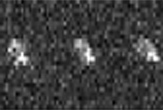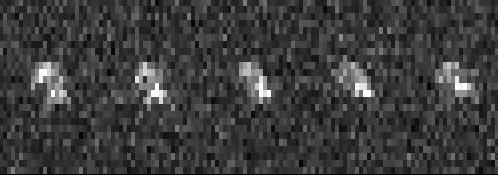http://www.space.com/scienceastronomy/080128-asteroid-radar.html

By Jeanna Bryner
Staff Writer
posted: 28 January 2008
09:44 am ET
Astronomers have obtained the first images of an asteroid on course to make its closest approach to Earth on Tuesday, showing the space rock is lopsided.
The new images, taken with the Goldstone Solar System Radar Telescope in California's Mojave Desert, refine estimates of the asteroid's size. Named 2007 TU24, the asteroid was estimated to span up to 2,000 feet (610 meters), but is now thought to have a diameter of about 800 feet (250 meters).
Scientists at NASA's Near-Earth Object Program Office at the Jet Propulsion Laboratory in Pasadena, Calif., have determined that there is no possibility of an impact with Earth in the foreseeable future.
Other radar telescopes will point toward the asteroid as it makes its closest approach to Earth, 334,000 miles (537,500 kilometers), at 3:33 a.m. Eastern time Jan. 29. For comparison, the moon is an average of 239,228 miles (385,000 kilometers) away.
At its nearest, the asteroid will reach an approximate apparent magnitude 10.3, or about 50 times fainter than an object visible to the naked eye in a clear, dark sky. Then, it will quickly get fainter as it moves away.
The combination of these telescopes, including the Arecibo Observatory in Puerto Rico, will provide higher resolution images of the asteroid. Measurements from Arecibo's radar telescope will gauge the object's size more precisely, its speed and spin. The Arecibo Observatory is operated by Cornell University on behalf of the National Science Foundation.
Like other asteroids, this one orbits the sun. Most do so in the asteroid belt between Mars and Jupiter. NASA pays particular attention to those whose orbits bring them so close to Earth.
TU24, discovered by NASA's Catalina Sky Survey on Oct. 11, 2007, is one of an estimated 7,000 near-Earth objects identified to date (another 7,000 are estimated to exist but are yet to be discovered).
"We have good images of a couple dozen objects like this, and for about one in 10, we see something we've never seen before," said Mike Nolan, head of radar astronomy at the Arecibo Observatory. "We really haven't sampled the population enough to know what's out there."

the Goldstone Solar System Radar Telescope in California's Mojave Desert. Credit: NASA/JPL-Caltech / 이 사진은 1픽셀이 20m정도 된다고 하는군요.
'별보기 > 하늘 소식' 카테고리의 다른 글
| Meteor Feb 19, 2008 (2) | 2008.02.29 |
|---|---|
| 제 16회 천체사진 공모전 (0) | 2008.02.02 |
| Here Comes Asteroid 2007 TU24 (0) | 2008.01.27 |
| Amazing Space: Tonight's Sky 2008, 01 (0) | 2008.01.23 |
| 07년 제19회 한국 아마추어 천문인의 밤 '별잔치 (STAR PARTY) (0) | 2007.11.02 |
